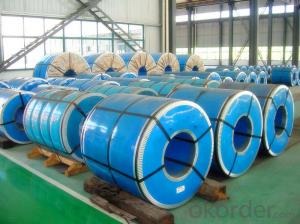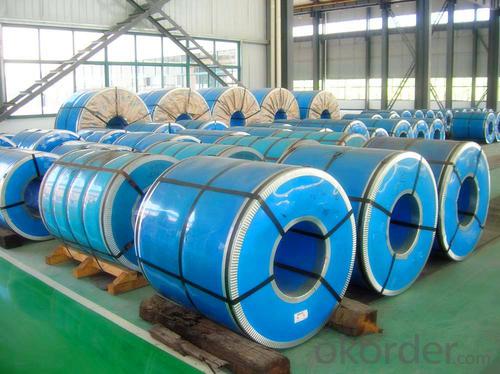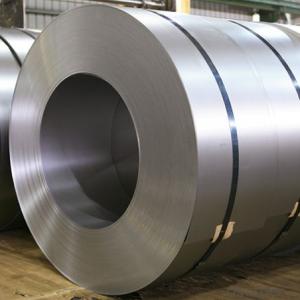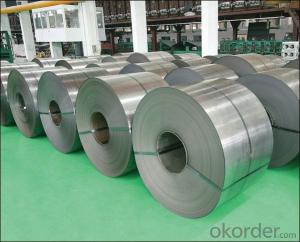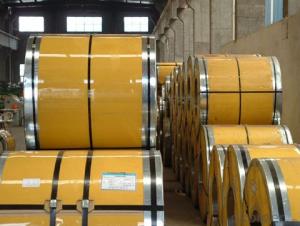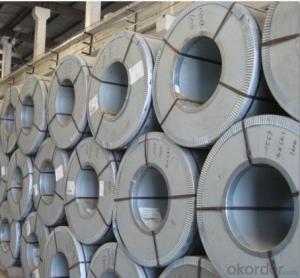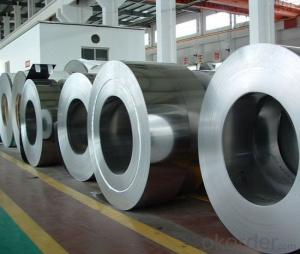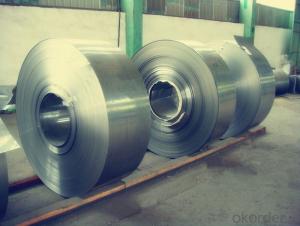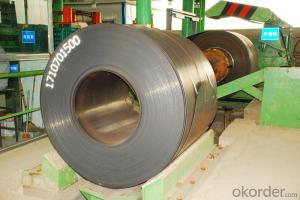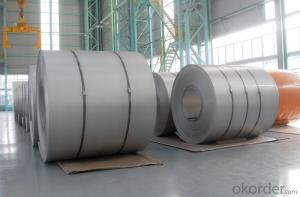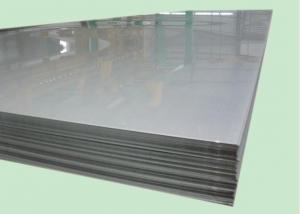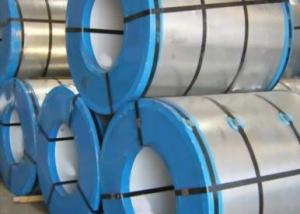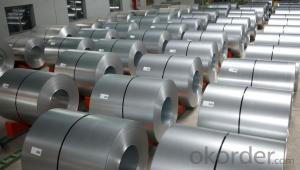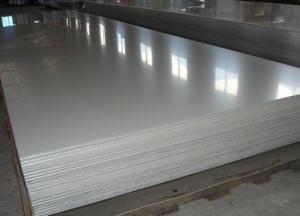Stainless Steel Coil 201 Hot Rolled Narrow Coil J1/J4
- Loading Port:
- Lianyungang
- Payment Terms:
- TT OR LC
- Min Order Qty:
- 400 m.t.
- Supply Capability:
- 5000 m.t./month
OKorder Service Pledge
OKorder Financial Service
You Might Also Like
Hot Rolled Stainless Steel Coil 201 Narrow Strip No.1 Finish
Packaging Detail: For customer's requirement
Delivery Detail: 10-30days
201 Hot Rolled Stainless Steel Coil Specifications
THK:2.3/2.5/3.0/4.0mm
Width:485/510/550/610/1010/1240mm
Face:No.1
201 Hot rolled stainless steel Coil Application
Stainless steel is a production which not easy rust,acid resistance and corrosion resistance,so it is widely
used in light industry,heavy industry,daily necessities and the decoration industry.
201 Hot Stainless Steel Coil Chemical Composition(WT%)
(C):≤0.15, (Si):≤0.75, (Mn):5.5~7.50, (Cr):16.0~18.0, (N):≤0.25, (Ni):3.50~5.50, (P):≤0.060, (S):≤0.030
201 Hot Rolled Stainless Steel Coil
Strength Of Extension:100,000 To 180,000 Psi;
Yield Strength:50,000 To 150,000 Psi
Elongation :55 To 60%;
Modulus Of Elasticity:29,000,000 Psi;
Density :.280lbs/Cubic Inch(7.93g/Cm3)
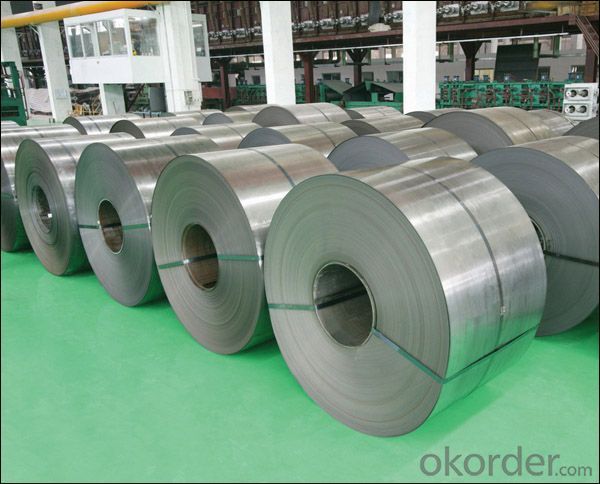
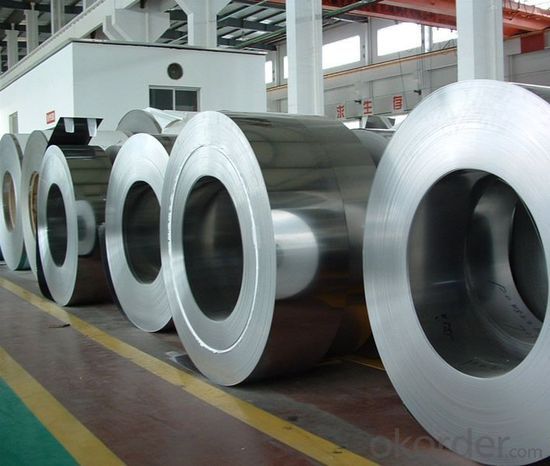
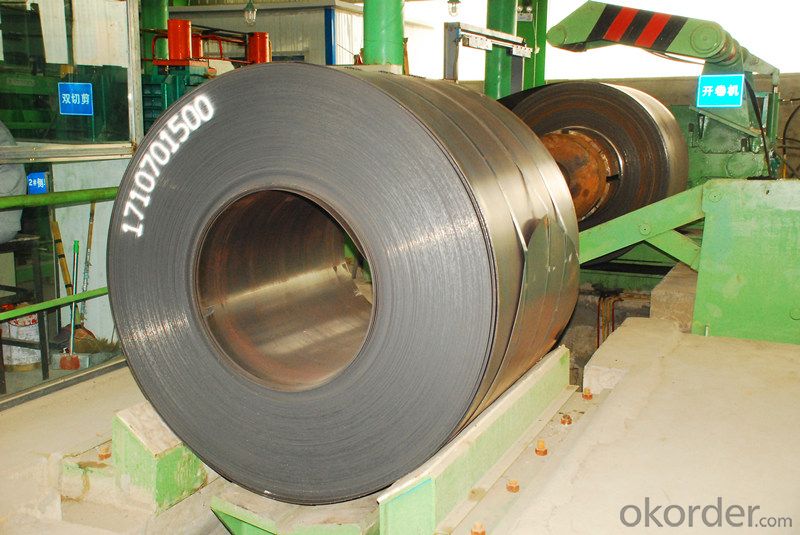
- Q: What is the hardness after heat treatment of stainless steel strips?
- The hardness of stainless steel strips after heat treatment can vary depending on several factors such as the specific grade of stainless steel, the heat treatment process used, and the desired outcome. Heat treatment of stainless steel strips is typically done to enhance certain properties such as hardness, strength, and corrosion resistance. During the heat treatment process, stainless steel strips are usually heated to a specific temperature and then cooled at a controlled rate. This allows for the transformation of the microstructure of the steel, resulting in changes to its mechanical properties. The hardness of the stainless steel strips after heat treatment is typically measured using a hardness testing method such as Rockwell or Vickers. Different heat treatment methods, such as annealing, quenching, tempering, or precipitation hardening, can be employed to achieve different hardness levels. For example, annealing is often used to soften the steel and improve its formability, resulting in lower hardness. On the other hand, quenching and tempering processes can increase the hardness of stainless steel strips by creating a martensitic structure. It is important to note that the hardness achieved through heat treatment should always be within the specified range for the particular stainless steel grade. The hardness requirements may vary depending on the intended application and the specific standards or specifications that need to be met. In conclusion, the hardness of stainless steel strips after heat treatment can range from relatively low to high, depending on the specific heat treatment process used and the desired outcome. It is crucial to follow the appropriate heat treatment procedures and adhere to the specified hardness requirements to ensure the desired properties are achieved.
- Q: What is the machinability of stainless steel strips?
- The machinability of stainless steel strips can vary depending on the specific grade and composition of the stainless steel. However, in general, stainless steel strips tend to have lower machinability compared to other materials like carbon steel or aluminum. This is primarily due to the presence of chromium, which forms a protective oxide layer on the surface of stainless steel, making it harder to cut and shape. Additionally, stainless steel strips can have a tendency to work harden during machining, requiring special cutting tools and techniques to achieve desired results.
- Q: Can stainless steel strips be used in chemical storage applications?
- Yes, stainless steel strips can be used in chemical storage applications. Stainless steel is resistant to corrosion and has excellent strength, making it suitable for storing and handling various chemicals. Additionally, it is easy to clean and maintain, making it a reliable choice for chemical storage.
- Q: Can stainless steel strips be used in electronic applications?
- Stainless steel strips are indeed applicable for electronic purposes. Their exceptional corrosion resistance and mechanical properties render them suitable for a range of electronic components and devices. Connectors, terminals, springs, shields, and enclosures often utilize stainless steel due to its common usage. In electronic circuits, stainless steel strips guarantee dependable performance through their high strength and durability. Moreover, their non-magnetic properties make them an excellent fit for applications that demand minimal disruption to magnetic fields. All in all, stainless steel strips present numerous benefits for electronic use, which explains their popularity in the industry.
- Q: Can stainless steel strips be used in extreme temperature conditions?
- Stainless steel strips are capable of being used in extreme temperature conditions. This material is versatile and durable, able to endure a wide range of temperatures. Its exceptional heat resistance properties make it suitable for both high and low-temperature environments. Stainless steel strips maintain their structural integrity and mechanical properties even under intense heat. They also exhibit remarkable resistance to thermal expansion and contraction, ensuring stability in extreme temperature conditions. Moreover, stainless steel has excellent resistance to corrosion, oxidation, and scaling, making it an excellent choice for applications that involve temperature fluctuations and exposure to harsh environments. In conclusion, stainless steel strips are a dependable and efficient option for various industries that require materials capable of withstanding extreme temperatures.
- Q: How do you prevent microbiologically influenced corrosion of stainless steel strips?
- Microbiologically influenced corrosion (MIC) poses a common problem across various industries, including the corrosion of stainless steel strips. To maintain the integrity of these strips and prevent MIC, it is possible to implement several preventive measures: 1. Opt for Resistant Stainless Steel: Select stainless steel grades that exhibit resistance to MIC, such as 316L or higher-grade alloys. These alloys contain higher levels of molybdenum, which enhances their ability to resist microbiological corrosion. 2. Ensure a Smooth Surface Finish: Guarantee that the stainless steel strips possess a polished and smooth surface finish. Rough surfaces provide crevices and pits that facilitate the thriving of microorganisms and the initiation of corrosion. Consistent cleaning and polishing help maintain surface smoothness. 3. Regular Cleaning and Maintenance: Consistently clean and sanitize the stainless steel strips to eliminate any biofilms or organic matter that may harbor microorganisms. Employ industry-approved cleaning agents and techniques to eradicate potential sources of microbial growth. 4. Employ Biocide Treatments: Apply suitable biocides or antimicrobial coatings to the stainless steel strips. These treatments can impede the growth of microorganisms and prevent corrosion initiation. However, it is crucial to choose biocides that are compatible with stainless steel to avert any adverse reactions. 5. Control the Environment: Maintain appropriate environmental conditions by regulating temperature, humidity, and the presence of corrosive chemicals. Microorganisms thrive in specific conditions, and by managing these factors, microbial growth can be minimized. 6. Implement Cathodic Protection: Introduce cathodic protection techniques, such as impressed current or sacrificial anode systems, to provide an additional layer of corrosion protection. These techniques aid in mitigating the effects of MIC on stainless steel strips. 7. Regularly Inspect and Monitor: Conduct regular inspections to identify any indications of corrosion or microbial growth on stainless steel strips. Establish a monitoring program that encompasses visual inspections, microbiological testing, and corrosion rate measurements to detect early signs of MIC and take appropriate measures. By implementing these preventive measures, the likelihood of microbiologically influenced corrosion on stainless steel strips can be significantly reduced, thereby ensuring their durability and performance.
- Q: Are stainless steel strips suitable for marine environments?
- Stainless steel strips prove to be an ideal choice for marine environments due to their exceptional resistance to corrosion. The remarkable anti-corrosive properties of stainless steel have earned it a prominent position in various marine applications. The presence of chromium in stainless steel triggers the formation of a safeguarding oxide layer on its surface, effectively preventing both rusting and corrosion. This oxide layer serves as a formidable barrier, shielding the steel from the harsh marine conditions, including saltwater, moisture, and humidity. Moreover, stainless steel possesses formidable strength and durability, enabling it to withstand the rigorous demands that marine environments impose, such as waves, impacts, and fluctuations in temperature. Consequently, stainless steel strips are extensively utilized in marine sectors like boat construction, shipbuilding, offshore structures, and marine equipment.
- Q: How can 304 stainless steel and 201 stainless steel be distinguished by magnet?
- The steel of the oxide layer was removed, put a drop of water, rub rub after copper sulfate, such as discoloration, usually stainless steel; such as purple red, nonmagnetic high manganese steel, magnetic for ordinary steel or low-alloy steel.
- Q: What are the common uses of stainless steel strips in the semiconductor industry?
- Stainless steel strips have a variety of common uses in the semiconductor industry due to their unique characteristics and properties. Some of the major applications include: 1. Etching Process: Stainless steel strips are often utilized as etching masks during the semiconductor fabrication process. The strips are resistant to various chemical etchants and offer excellent corrosion resistance, making them ideal for protecting specific areas of the semiconductor surface during the etching process. 2. Wafer Handling: Stainless steel strips are used for handling delicate silicon wafers throughout the manufacturing process. The strips provide a clean and contamination-free surface, preventing any damage or contamination that could affect the quality of the wafers. 3. Cleanroom Construction: Stainless steel strips are commonly used in the construction of cleanrooms within the semiconductor industry. These strips are preferred due to their high resistance to corrosion, durability, and ability to withstand harsh cleaning chemicals used in cleanroom maintenance. 4. ESD Protection: Electrostatic discharge (ESD) can cause significant damage to sensitive semiconductor components. Stainless steel strips are used as grounding strips or ESD protection strips to dissipate any static charges and prevent damage to the semiconductor devices during the assembly and testing processes. 5. Heat Exchangers: Stainless steel strips are employed in the construction of heat exchangers used to regulate temperature during various semiconductor manufacturing processes. The strips' excellent thermal conductivity and corrosion resistance make them suitable for transferring heat efficiently while maintaining a clean and sterile environment. 6. Surface Mount Technology (SMT): Stainless steel strips are also used in the SMT process, where electronic components are directly mounted onto the surface of a printed circuit board. The strips serve as solder stencils, facilitating the precise application of solder paste onto the board, ensuring accurate placement of components during the assembly process. Overall, stainless steel strips are valued in the semiconductor industry for their corrosion resistance, cleanliness, durability, and ability to withstand extreme conditions, making them indispensable in various stages of semiconductor manufacturing.
- Q: How do stainless steel strips perform in high temperature environments?
- Stainless steel strips perform exceptionally well in high temperature environments due to their excellent heat resistance properties. They maintain their strength and structural integrity, without deformation or warping, even under extreme heat conditions. This makes stainless steel strips a reliable choice for various applications in industries like aerospace, power generation, and automotive, where high temperatures are prevalent.
Send your message to us
Stainless Steel Coil 201 Hot Rolled Narrow Coil J1/J4
- Loading Port:
- Lianyungang
- Payment Terms:
- TT OR LC
- Min Order Qty:
- 400 m.t.
- Supply Capability:
- 5000 m.t./month
OKorder Service Pledge
OKorder Financial Service
Similar products
Hot products
Hot Searches
Related keywords
